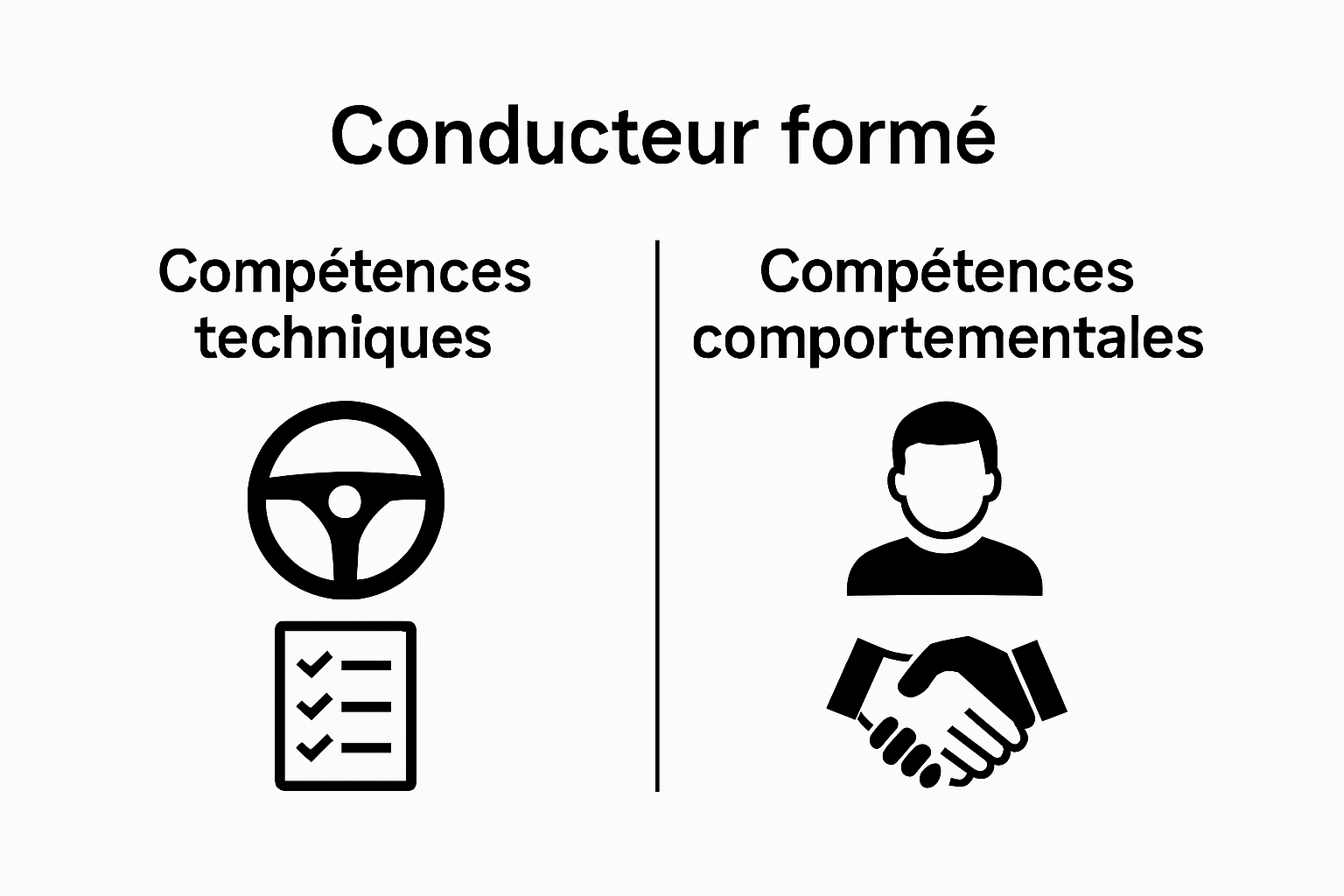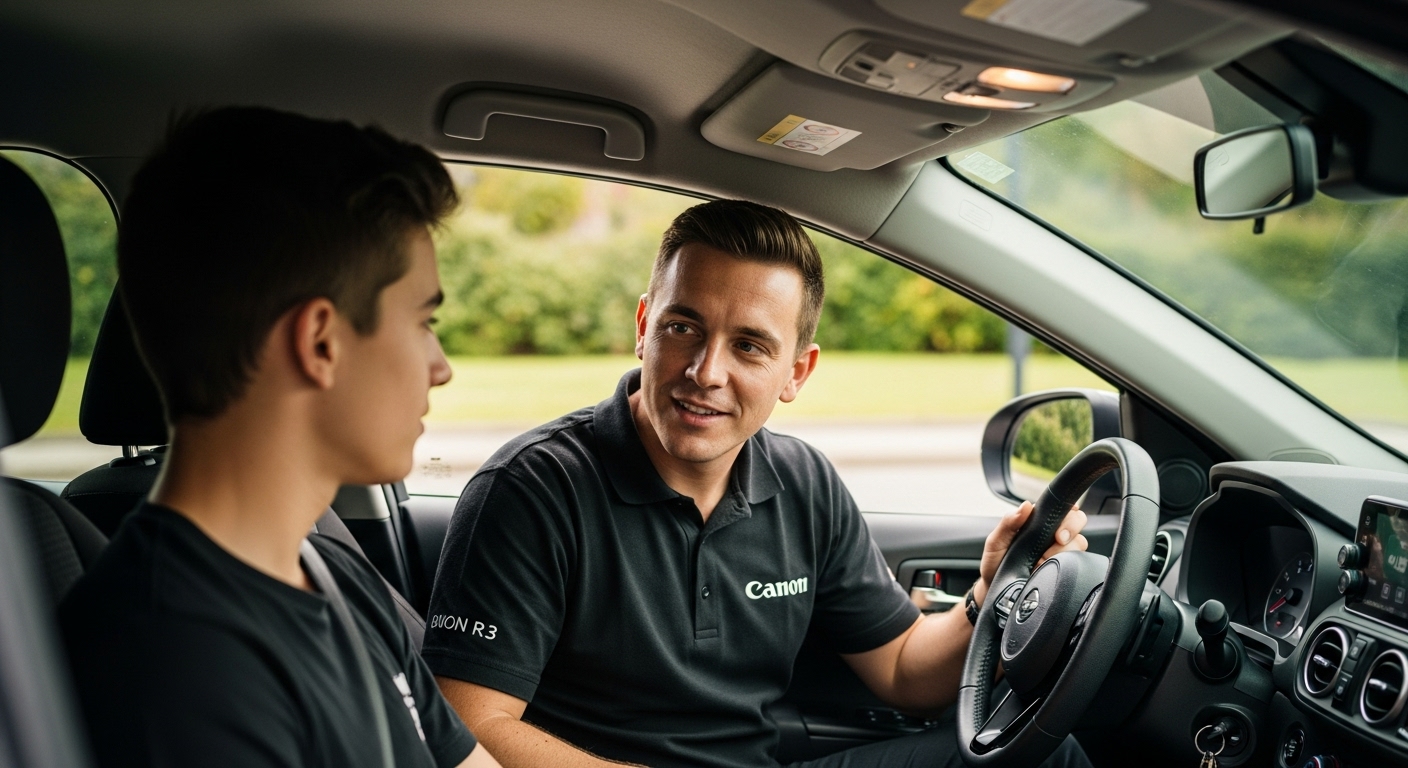Learning to drive isn’t just about turning a key and hitting the road. There are over 60 minutes of guided practice in every lesson, and every minute counts for safety. Yet it’s not the duration that makes the difference, but the transformation of the student into a responsible driver that changes everything.
Table of contents
- Definition of a driving lesson
- The objectives and importance of the driving lesson
- The role of the instructor and the student in the lesson
- Practical aspects of learning to drive
- The impact of driving lessons on road safety
Quick summary
| Awareness | Explanation |
|---|---|
| Learning goes beyond technique | Driving lessons aim to develop practical skills while cultivating a responsible attitude on the road. |
| Focus on road safety | The main aim is to reduce accidents by teaching defensive driving and anticipating dangerous situations. |
| Progressive teaching approach | Lessons are structured to build students’ confidence and skills, starting from controlled environments to more complex situations. |
| Active role of the student | Students must be actively involved in their training, practicing regularly and being open to constructive criticism. |
| Importance of the instructor | A good instructor assesses the student’s level and adapts the teaching to ensure effective, personalized learning. |
Definition of a driving lesson
A driving lesson is a structured learning experience that enables a learner to develop the skills needed to drive a vehicle safely and responsibly. This learning experience goes far beyond simply knowing how to handle a steering wheel and press the pedals.
The essential components of a driving lesson
Driving lessons are generally given by professional instructors and comprise two fundamental aspects: theory and practice. Each lesson aims to impart precise knowledge and develop appropriate driving reflexes.
- Learning the rules of the road
- Understanding signs and signals
- Safe driving techniques
- Managing high-risk situations
According to the Swiss Association of Driving Instructors, a standard lesson generally lasts between 60 and 90 minutes, providing ample time for in-depth study of techniques and concepts.
Educational objectives of a driving lesson
The main aim of a driving lesson is not simply to learn to drive, but to develop a responsible and aware driver. This involves developing several key skills:
- Perception and anticipation of traffic situations
- Technical control of the vehicle
- Compliance with regulations
- Developing a cautious attitude
Each lesson is built up progressively, from the basics to more complex and dynamic driving situations. The instructor constantly adapts his teaching to the student’s level and pace, guaranteeing effective, personalized learning.
Below is a table summarizing the main components and pedagogical objectives of a driving lesson, to make them easier to understand.
| Component or Objective | Concise description |
|---|---|
| Learning the Highway Code | Understand the rules and signs to ensure safe driving |
| Technical control of the vehicle | Acquire basic gestures and reflexes to control the vehicle |
| Anticipating situations | Develop the ability to anticipate and react to the unexpected |
| Responsible attitude | Adopt a cautious attitude, respectful of other users |
| Progressive teaching | Structure learning from simple to complex |
The objectives and importance of the driving lesson
Driving lessons are much more than just technical training. They constitute a complete training process designed to transform the learner into a responsible driver, capable of making informed and safe decisions on the road.
Road safety training
The main aim of driving lessons is to reduce the risk of accidents and promote a responsible driving culture. This involves not only the acquisition of technical skills, but also the development of an acute awareness of safety issues.
- Understanding traffic rules
- Anticipate the behavior of other users
- Managing stress and unexpected situations
- Develop defensive driving reflexes
According to the Federal Roads Office, driver training plays a crucial role in reducing road accidents, especially among young drivers.
Technical and behavioral skills development
Driving lessons aim to create a complete driver, developing both technical skills and responsible attitudes.
 This requires a global approach that goes beyond simple mechanical control of a vehicle.
This requires a global approach that goes beyond simple mechanical control of a vehicle.
- Technical control of the vehicle
- Understanding interactions with the road environment
- Developing ethical conduct
- Adapting to different traffic conditions
Each lesson is a progressive learning opportunity, where the student builds confidence and competence under the supervision of an experienced instructor. The ultimate aim is to create autonomous, aware and responsible drivers, capable of protecting not only their own lives, but also those of other road users.
The role of the instructor and the student in the lesson
Driving lessons are based on a dynamic, collaborative interaction between instructor and student. Each party plays a crucial role in the learning process, contributing together to the development of a competent and responsible driver.
The instructor’s role: guide and facilitator
The instructor is not simply a transmitter of knowledge, but a true pedagogical guide. His mission goes far beyond the technical teaching of driving rules.
- Accurate assessment of the student’s initial level
- Adapting teaching methods to individual abilities
- Impart safe driving techniques
- Creating a reassuring learning environment
According to the Swiss Association of Driving Instructors, a good instructor must combine technical expertise with human qualities to encourage learning.
The role of the student: a key player in his or her training
Learning to drive requires active, responsible involvement on the part of the student. It is not a passive process, but a personal process of skill development.
- Listen carefully to the instructor’s advice
- Practice regularly and with concentration
- Accept constructive criticism
- Develop critical thinking about one’s own conduct
Successful learning depends directly on the motivation and personal involvement of the student. The instructor guides, but it’s the student who really builds competence.
Here’s a comparison chart to clarify the respective roles and responsibilities of the instructor and the student during a driving lesson.
| Role | Main responsibilities | Final objective |
|---|---|---|
| Instructor | Assess the student’s level, adapt teaching methods, transmit safe techniques, create a reassuring environment | Guide learning and ensure safety |
| Student | Listen, practice, accept criticism, reflect on conduct | Acquire autonomy and responsibility |
Practical aspects of learning to drive
Learning to drive is a complex process that combines several practical dimensions, from theoretical preparation to hands-on experience on the road. Each stage is designed to gradually build the future driver’s confidence and skills.
Preparation and learning progression
The practical approach to learning to drive is based on a fundamental principle of gradual progression. Lessons are structured to enable students to develop their skills systematically and safely.
- Getting started in controlled environments
- Gradually increase the complexity of situations
- Master basic maneuvers before complex situations
- Develop a global perception of the road environment
According to the Federal Roads Office, this progressive approach significantly reduces the risk of accidents for new drivers.
Techniques and practical exercises
Driving lessons include a variety of practical exercises designed to develop the driver’s reflexes and confidence. These exercises cover different aspects of driving, from pure technique to complex traffic situations.
- Vehicle positioning exercises
- Practicing different types of parking
- Intersection and priority management
- Driving on freeways and trunk roads
Each exercise is carefully selected to give the student a complete and nuanced understanding of driving.
 The aim is to create a driver who is not only technically proficient, but also capable of analyzing and reacting effectively to unforeseen situations.
The aim is to create a driver who is not only technically proficient, but also capable of analyzing and reacting effectively to unforeseen situations.
The impact of driving lessons on road safety
Driving lessons represent a crucial investment in accident prevention and the promotion of a responsible driving culture. Over and above technical training, these courses play a fundamental role in reducing road risks and protecting human lives.
Reducing risk behaviors
One of the most significant impacts of driving lessons is the reduction in dangerous behavior on the road. Modern training courses not only teach driving techniques, but also develop an acute awareness of risks and responsibilities.
- Developing perception of potential hazards
- Learn to react appropriately in critical situations
- Understanding the consequences of reckless behavior
- Training to manage stress and emotions at the wheel
According to the Federal Roads Office, structured driving lessons make a significant contribution to reducing accidents among young drivers.
Defensive driving training
Driving lessons focus on the principles of defensive driving, an approach that goes beyond mere technical control of the vehicle. This method aims to anticipate and prevent potentially dangerous situations before they arise.
- Techniques for anticipating the movements of other users
- Maintaining appropriate safety distances
- Adapting to the environment and weather conditions
- Managing risk zones on the road
The ultimate aim of these lessons is to turn every driver into a responsible road safety player, capable of protecting not only his or her own life, but also that of other road users.
Ready to master the basics of driving with confidence?
You’ve understood that a driving lesson isn’t just about technique. Being well-prepared, managing your first hours behind the wheel and knowing how to anticipate risks are often the challenges that worry you most before taking the plunge. Thanks to structured, personalized support, you can quickly acquire the right reflexes to become a responsible, serene driver.
Choose Auto-École Lémanique for safe, efficient progress. Discover our courses designed for every stage of your learning process, meet our team of passionate instructors and consult the opinions of our former students so you can act with confidence. Book your first lesson now via our official website and don’t let uncertainty hold back your licensing plans. Take advantage of our comprehensive and transparent approach to get you on your way to obtaining your license with complete peace of mind.
Frequently asked questions
What is a driving lesson?
A driving lesson is an educational experience that enables a learner to develop the skills needed to drive a vehicle safely and responsibly, by integrating theory and practice.
What are the objectives of a driving lesson?
The objectives of a driving lesson include road safety training, the development of technical and behavioral skills, and preparation for handling complex traffic situations.
How long does a driving lesson usually last?
A standard driving lesson usually lasts between 60 and 90 minutes, which is plenty of time to get to grips with driving techniques and concepts.
What is the instructor’s role in a driving lesson?
The instructor assesses the student’s level, adapts the pedagogy to his/her needs, transmits safe driving techniques, and creates a positive learning environment.





